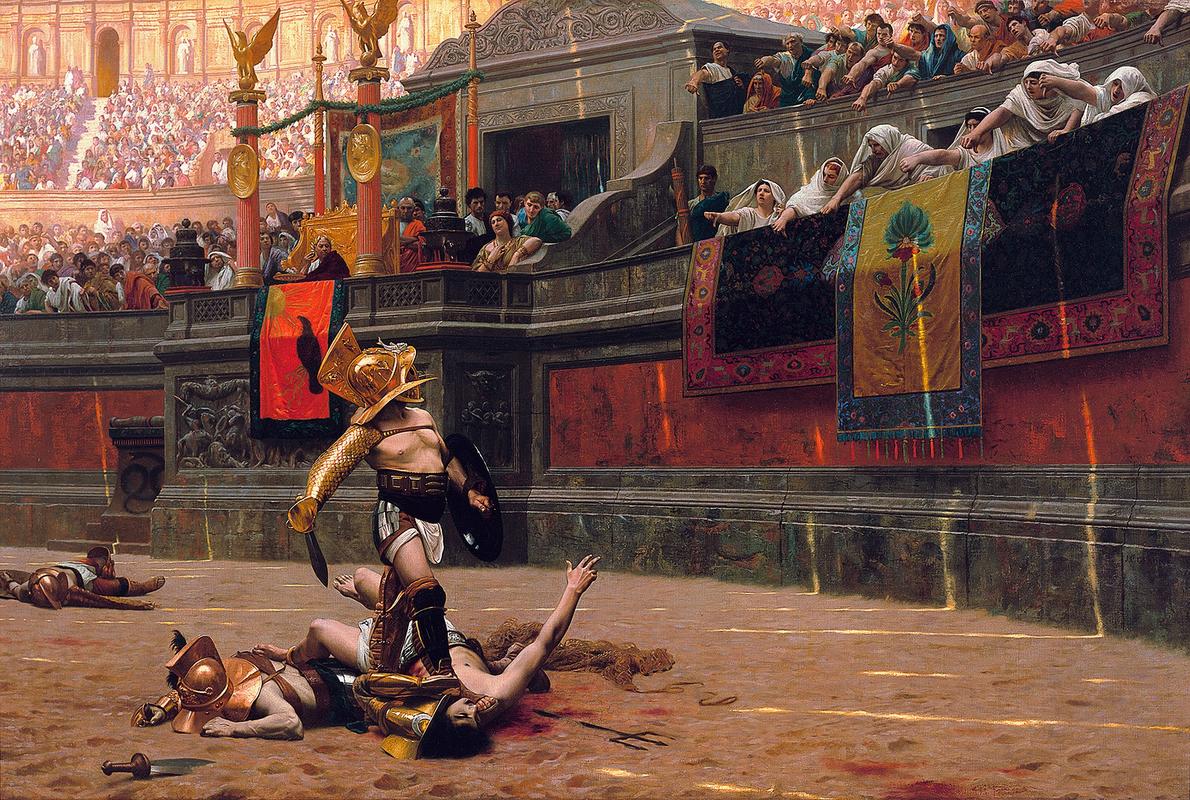More about Pollice Verso (Thumbs Down)

Contributor
No, Pollice Verso doesn’t mean that two cops are talking to each other.
It’s the name of a painting by artist Jean-Léon Gérôme that roughly translates to “turned thumb”, a hand gesture derived from the Roman gladiator days.
Pollice Verso, whether you’ve seen it before or not, could be responsible for why we attribute thumbs up to mean good, and thumbs down to mean bad. It was a gesture given by the audience to tell a gladiator what they wanted them to do to a fallen fighter. Depending on the gesture, they could tell them to kill the loser, or spare him. But in the 21st century, nobody can agree which expression implied what. Some people believe the thumbs up meant they wanted them to live, and thumbs down meant they wanted them to die. Some people say it was the opposite of that. And there isn’t enough evidence to support either claim. The mystery surrounding the true meaning of the thumbs only adds to the level of suspense conveyed in the scene.
That uncertainty and intrigue of this painting was what convinced renowned filmmaker Ridley Scott to direct the movie "Gladiator" (2000). “That image spoke to me of the Roman Empire in all its glory and wickedness." Pollice Verso really feels like a screenshot from a movie. Great cinematography means that you could pause any section of a film, and the frame on the screen should be worthy of hanging up in a museum. This painting has that same quality, except, you know, it’s already in a museum. But it isn’t hard at all to see how this type of painting could inspire a director. Especially when you realize that this was created before filmmaking was even a thought. Gladiator is wildly historically inaccurate, down to the “pollice verso” gesture itself, but at the end of the day, it’s still a testament of respect when art inspires art.
It’s hard not to feel the presence of the scene in Pollice Verso. There are so many stories being told from corner to corner. You almost feel compelled to show others so they can feel what you’re feeling. And the best way to do that is post it on social media. But you wouldn’t post the pic in its entirety on Instagram, you’d probably slice it up into smaller images that were zoomed and cropped into the areas that invoke the most emotion. Like the Vestal Virgins (the group of women in white veils), the varied faces of the audience in the Coliseum, the sandal on the throat of the defeated fighter, and the intricate golden armor of the victorious gladiator. Despite your better judgment, you’d decide to post it on Facebook as well so it can get more exposure. Everyone should appreciate this work of art. And amongst the irrelevant comments from your mom telling you to call her, and the gif of Bert and Ernie from your uncle, you see a plethora of likes in the form of a blue and white “thumbs up” in your notifications. The circle is now complete.
Sources
- Britannica.com “Jean-Leon Gerome.” Accessed October 25, 2018. https://www.britannica.com/biography/Jean-Leon-Gerome
- Italy Magazine.com “Thumbs Up or Thumbs Down? From Gladiator to FB, The Roman Roots of Pollice Verso. Accessed October 25, 2018. http://www.italymagazine.com/dual-language/thumb-or-thumb-down-gladiato…
- Knight, Christopher. Art review: 'The Spectacular Art of Jean-Léon Gérôme' @ J. Paul Getty Museum” LA Times. June 21, 2010. Accessed October 25, 2018. https://latimesblogs.latimes.com/culturemonster/2010/06/art-review-the-…
- Mischalska, Magda. “Naked Truth About Academic Art.” Daily Art. October 1. 2016. Accessed October 25, 2018. http://www.dailyartmagazine.com/naked-truth-academic-art/
- Smallwood, Karl. “The Truth About Gladiators And The Thumbs Up.” October 23, 2014. Accessed October 25, 2018. http://www.todayifoundout.com/index.php/2014/10/give-thumbs-gesture-get…
- Spier, Christine. “Thumbs Up or Thumbs Down? Looking at Gerome’s “Pollice Verso”’ August, 6, 2010. Accessed October 25, 2018. http://blogs.getty.edu/iris/thumbs-up-or-thumbs-down-looking-at-geromes…
Featured Content
Here is what Wikipedia says about Pollice Verso (Gérôme)
Pollice Verso (from Latin: with a turned thumb) is an 1872 painting by French artist Jean-Léon Gérôme, featuring the eponymous Roman gesture directed to the winning gladiator.
The thumbs-down gesture in the painting is given by spectators at the Colosseum, including the Vestals, to the victorious murmillo, while the defeated retiarius raises two fingers to plead for mercy. The painting was an inspiration for the 2000 film Gladiator, where Commodus holds out a raised thumb to spare the film's hero, Maximus.
Check out the full Wikipedia article about Pollice Verso (Gérôme)













All this movement reminds me of https://www.sartle.com/artwork/the-four-continents-peter-paul-rubens